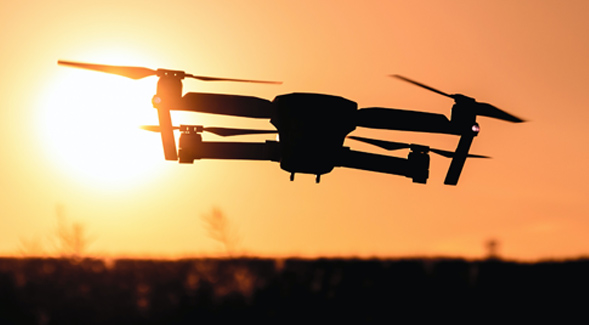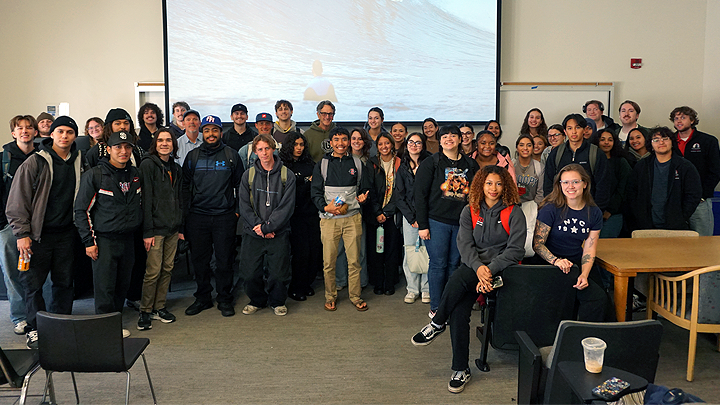Drones that Can Calculate, Communicate and Solve Complex Problems
SDSU engineering researcher Junfei Xie receives a National Science Foundation award to develop a flying cloud computing system in the air.

Imagine a drone that can perform complex calculations while up in the air, communicate with other drones in its network and harness artificial intelligence to provide smart services, such as crowd control, traffic monitoring, and emergency response.
If it sounds far-fetched, it’s actually not — a San Diego State University engineering researcher is working on developing a theoretical framework for networked airborne computing that will make this a reality sooner rather than later.
Junfei Xie is an assistant professor in SDSU’s Department of Electrical and Computer Engineering, whose background as well as research focus combine interdisciplinary knowledge from both these fields. She recently received the CAREER award from the National Science Foundation (NSF), given to promising early career researchers to further advance their research.
Spread over five years, the $550,000 award will help Xie build on her previous work and develop a system for drones to have networked airborne computing capability.
“Junfei is one of the most talented and prolific young researchers of the College. In less than two years since she joined SDSU, she has obtained three NSF grants, including the prestigious Career Award,” said Eugene Olevsky, dean of the College of Engineering. “Junfei has already received recognition and made a significant mark on networked airborne computing in terms of substance, quality and creativity.”
Xie, who leads the Systems and Intelligence Laboratory better known as the SMILE lab in the College of Engineering, spoke with SDSU NewsCenter about how the award will help her push the boundaries of what drones can do while deployed.
What motivated you to focus on drone research?
My Ph.D. mentor, Yan Wan at the University of Texas at Arlington, led me to this field. Part of my Ph.D. dissertation was on developing the theoretical foundation and applied results to enable airborne networks formed by drones with direct flight-to-flight communication links.
Before I accessed this field, my knowledge of drones was mainly from the movies, and I never thought drones could one day be commercialized and be accessible and affordable for everyone. So I was very excited to explore this new technology. I witnessed the growing popularity of drones and also realized the importance of drones to our future life, as it has such a wide range of applications.
However, drone technology is far from mature and there are many research questions that remain to be answered in order to develop the potential of drones to the full extent. This drove me to keep exploring this field after graduate school.
How will this NSF grant help you build on your work with drones?
It will help me develop an innovative theoretical framework to enable networked airborne computing by tapping the network formed by aerial vehicles, with direct flight-to-flight links to achieve computing in the air. We will test and implement these algorithms and explore real-world applications of networked airborne computing. This grant will also support a doctoral student and a graduate student researcher, as well as development of innovative education and outreach activities such as virtual lab modules, summer camps and internships.
Once they have computational capabilities, what will the drones be able to do?
Existing drone systems have limited computing capability and this technology will equip drones with advanced onboard computing capability. This will enable drones to run advanced algorithms to perform complicated tasks.
For example, drones can run AI algorithms to improve operational safety during severe weather, enhance situational awareness in hostile environments such as war zones, and to facilitate emergency response teams to search for and rescue survivors when disaster happens.
This technology will also give rise to a variety of new applications such as facilitating data collection, processing and distribution for IoT (Internet of Things) devices. Drones can also function as a server to provide computing services to ground users, so that people can play video games anywhere and anytime, even using basic cell phones for example.
What impact will this project have, aside from advancing drone technology?
Besides creating broad civilian and economic advancements related to drone-based applications, the innovative education and outreach activities will have a positive impact on the community and significantly benefit students, especially underrepresented minorities in San Diego County and beyond. The workshops and tutorials will further broaden the impact of this project and benefit the general public.



